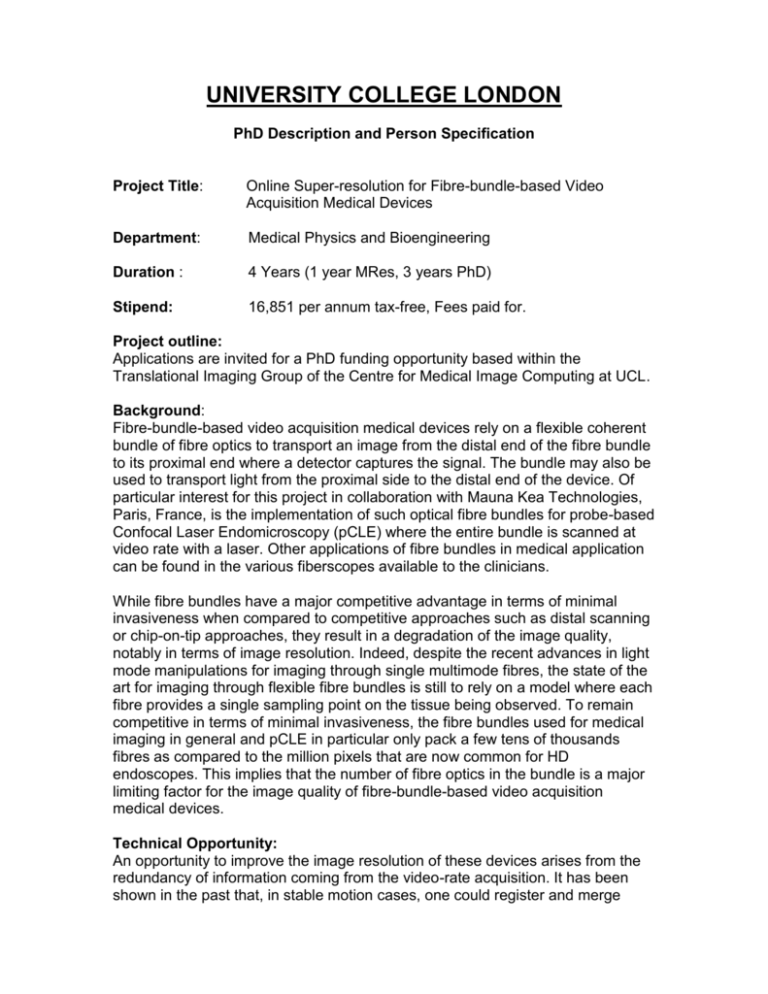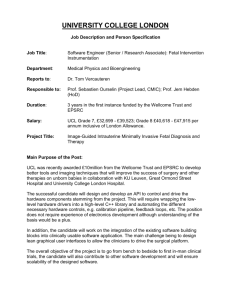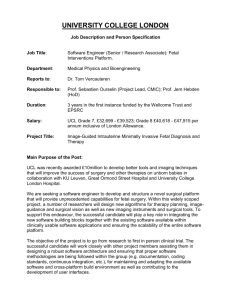Further Particulars - TIG
advertisement

UNIVERSITY COLLEGE LONDON PhD Description and Person Specification Project Title: Online Super-resolution for Fibre-bundle-based Video Acquisition Medical Devices Department: Medical Physics and Bioengineering Duration : 4 Years (1 year MRes, 3 years PhD) Stipend: 16,851 per annum tax-free, Fees paid for. Project outline: Applications are invited for a PhD funding opportunity based within the Translational Imaging Group of the Centre for Medical Image Computing at UCL. Background: Fibre-bundle-based video acquisition medical devices rely on a flexible coherent bundle of fibre optics to transport an image from the distal end of the fibre bundle to its proximal end where a detector captures the signal. The bundle may also be used to transport light from the proximal side to the distal end of the device. Of particular interest for this project in collaboration with Mauna Kea Technologies, Paris, France, is the implementation of such optical fibre bundles for probe-based Confocal Laser Endomicroscopy (pCLE) where the entire bundle is scanned at video rate with a laser. Other applications of fibre bundles in medical application can be found in the various fiberscopes available to the clinicians. While fibre bundles have a major competitive advantage in terms of minimal invasiveness when compared to competitive approaches such as distal scanning or chip-on-tip approaches, they result in a degradation of the image quality, notably in terms of image resolution. Indeed, despite the recent advances in light mode manipulations for imaging through single multimode fibres, the state of the art for imaging through flexible fibre bundles is still to rely on a model where each fibre provides a single sampling point on the tissue being observed. To remain competitive in terms of minimal invasiveness, the fibre bundles used for medical imaging in general and pCLE in particular only pack a few tens of thousands fibres as compared to the million pixels that are now common for HD endoscopes. This implies that the number of fibre optics in the bundle is a major limiting factor for the image quality of fibre-bundle-based video acquisition medical devices. Technical Opportunity: An opportunity to improve the image resolution of these devices arises from the redundancy of information coming from the video-rate acquisition. It has been shown in the past that, in stable motion cases, one could register and merge consecutive images to create larger field of view mosaic images. A by-product of this work was to demonstrate an increase in image quality and image resolution after the merging operation. This can be explained by signal-to-noise ratio considerations but also by the fact that some aliasing may still be present in the individual images. While image quality improvements have been achieved, it should however be noted that it required heavy computations not compatible with online implementations and that it only handles smooth motion patterns. Scientific PhD Objectives. The goal of this PhD is to develop an online method to improve the image quality and resolution of fibre-bundle-based video acquisition medical devices. For each image, we envision to rely on 1) real-time image registration to collect redundant information from previous frames and 2) machine learning to drive indication-specific interpolation / in-painting techniques. The machine learning part will require training data. Such training data may be gathered for stable motion videos where high-resolution images can be generated with the previous time-consuming algorithm or may be generated in silico thanks to simulation and domain adaptation. Envisioned Impact. The PhD project will focus on pCLE imaging, taking into account its specificities and target clinical applications. To a small extent, it will also evaluate the potential of using the developed technologies for other fibrebundle-based imaging device such as fetoscopes or cholangioscopes. For pCLE application, improving the image quality and resolution may not be the strongest expressed need from the clinicians point of view. However, we do believe that, as much as HD took over SD in traditional endoscopy mostly because of physician comfort rather that expressed need, super-resolved pCLE, once available, will become a feature deemed essential by the physicians. Furthermore, super-resolved pCLE will allow pushing the boundaries of the current resolution versus field of view (FOV) trade-off. Indeed, the distal optics of the current most widely used clinical pCLE miniprobes have been designed to provide a very high resolution, sufficient to see the details of cellular architecture, at the expense at the FOV. With super-resolution in place, it will be possible to design pCLE miniprobes that 1) have a larger FOV 2) have a default resolution that only allows for imaging the gist of the cellular architecture but 3) can image the details of the cellular architecture once super-resolution is turned on. Although this would require hardware development on the miniprobe side in addition to software developments, this is advantageous because increasing the FOV is an expressed need by many pCLE users. Finally, super-resolution can potentially be beneficial to any computational tools that use the images produced by pCLE as input. Image quality improvement can for example be beneficial for further image registration-based tools and for content-based image retrieval tools. This may potentially lead to better outcomes for computer-aided diagnosis support systems based on such tools. Candidates with a strong interest in the following areas are encouraged to apply for this PhD in collaboration with Mauna Kea Technologies: machine learning, medical image registration, computer vision, translational applications of medical image computing, and real-time image processing. To apply: In order to be eligible, applicants will have achieved (or are predicted) a first class or upper second class honours undergraduate degree (or equivalent international qualifications or experience) in a related subject. To apply please send your CV and a cover letter outlining your motivations for applying for this PhD and how your educational background, skills and experience fit the programme to: applications@medphys.ucl.ac.uk The studentship compromises of fees and a tax-free stipend of £16,851 per annum. In order to qualify candidates must be UK/EU passport holders or qualify for UCL home fees status. If you wish to discuss this opportunity, please contact Dr. Tom Vercauteren (t.vercauteren@ucl.ac.uk ) but please note applications need to be submitted using the above instructions. The successful applicant to this project will join the UCL Centre for Doctoral Training in Medical Imaging programme, for more information please go to: http://www.ucl.ac.uk/imaging-cdt For more information about the Translational Imaging Group: http://cmictig.cs.ucl.ac.uk/ Person Specification: Essential Desirable Knowledge, Education, Qualifications and Training Upper Second Honours degree (or equivalent) in Physics, Engineering, or Computer Science from a recognised university. Postgraduate degree (MSc) in medical image computing, medical physics or closely related subject *** *** Skills and/or Abilities Strong mathematical abilities *** Strong problem solving abilities *** Good understanding of the basis for medical imaging (e.g. Endoscopy, MRI, Ultrasound) or optical imaging (e.g. Microscopy, OCT) *** Ability to develop computer object-oriented software using C++ and python *** Understanding of the principles and practice of digital image processing and medical image analysis *** Ability to work effectively within a collaborative environment *** *** Proficiency in MATLAB programming *** Excellent written and spoken communication skills in English Experience Experience of algorithm and software development for medical image analysis, digital image processing or computer vision *** Other requirements Strong interest in medical image analysis and the application of imaging technology to solving medical problems ***








